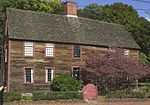Fort Heath
All pages needing factual verificationBuildings and structures in Suffolk County, MassachusettsCoastal artillery installations of the United States ArmyDemolished buildings and structures in MassachusettsForts in Massachusetts ... and 6 more
Geographic coordinate listsInstallations of the U.S. Army in MassachusettsLists of coordinatesWinthrop, MassachusettsWorld War II sites in the United StatesWorld War I sites in the United States

Fort Heath was a US seacoast military installation for defense of the Boston and Winthrop Harbors with an early 20th-century Coast Artillery fort, a 1930s USCG radio station, prewar naval research facilities, World War II batteries, and a Cold War radar station. The fort was part of the Harbor Defenses of Boston (Coast Defenses of Boston 1913–1925) and was garrisoned by the United States Army Coast Artillery Corps. The fort's military structures have been replaced by a residential complex, including the luxurious Forth Heath Apartments, and recreation facilities of Small Park, which has both a commemorative wall and an historical marker for Fort Heath.
Excerpt from the Wikipedia article Fort Heath (License: CC BY-SA 3.0, Authors, Images).Fort Heath
Seal Harbor Road,
Geographical coordinates (GPS) Address Nearby Places Show on map
Geographical coordinates (GPS)
| Latitude | Longitude |
|---|---|
| N 42.389544444444 ° | E -70.969486111111 ° |
Address
Seal Harbor Road
02152
Massachusetts, United States
Open on Google Maps









